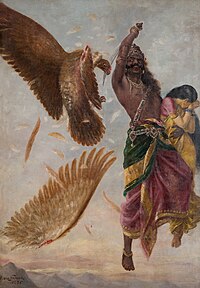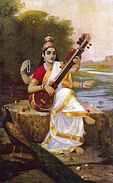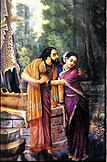Raja Ravi Varma (April 29, 1848 - October 2, 1906) was an Indian painter from the princely state of Travancore who achieved recognition for his depiction of scenes from the epics of the Mahabharata and Ramayana. His paintings are considered to be among the best examples of the fusion of Indian traditions with the techniques of Europeanacademic art.
Varma is most remembered for his paintings of beautiful sari-clad women, who were portrayed as shapely and graceful. His exposure in the west came when he won the first prize in theVienna Art Exhibition in 1873. Raja Ravi Varma died in 1906 at the age of 58. He is considered among the greatest painters in the history of Indian art
| Raja Ravi Varma | |
|---|---|
 | |
| Born | April 29, 1848 Kilimanoor, Travancore |
| Died | October 2, 1906 (aged 58) Kilimanoor, Travancore, India |
| Occupation | Painter |
Life
Raja Ravi Varma got married to Rani Bhageerathi Bayi (Kochu Panki Amma) of Mavelikara Royal House. He spent the later years of his life in Mysore, Baroda and a number of other cities in the country. This exposure helped him in broadening his outlook. At the same time, he was able to expand as well as sharpen his skills and evolve into a mature painter.
Raja Ravi Varma is most remembered for his paintings of beautiful sari clad women, who were portrayed as very shapely and graceful. His exposure in the west came when he won the first prize in Vienna Art Exhibition in 1873. After a successful career as a painter, Raja Ravi Varma died in 1906 at the age of 58. He is generally considered as one among the greatest painters in the history of Indian art.
Prominent works
The following is a list of the prominent works of Ravi Varma.
Village Belle
Lady Lost in Thought
Damayanti Talking to a Swan
The Orchestra
Arjuna and Subhadra
Lady with lemon
The Heartbroken
Swarbat Player
Shakuntala
Lord Krishna as Ambassador
Jatayu, a bird devotee of Lord Rama is mauled by Rawana
Victory of Indrajit
A Family of Beggars
A Lady Playing Swarbat
Lady Giving Alms at the Temple
Lord Rama Conquers Varuna
Nair Woman
Romancing Couple
Draupadi Dreading to Meet Kichaka
Shantanu and Matsyagandha
Shakuntala Composing a Love Letter to King Dushyanta
Girl in Sage Kanwa's Hermitage (Rishi-Kanya)
Asthasiddi
Lakshmi
Saraswati
bheesma pledge
Yashoda decorating Krishna
Gangavataranam
Ravi VarmaShakuntala, a character in the epic Mahabharata]]
Shakuntala despondent
Philosophical outlook
Raja Ravi Varma's philosophical outlook is not known or documented, especially his understanding of Western Art forms, though it should be acknowledged that he received formal and systematic training. Those who seek to critically examine his contribution are severely impaired in their project by the absence of any literature written by him. (one would require an interpretation of the diary maintained by his younger Brother, C. Raja Raja Varma, himself an accomplished painter, who in later years assisted him in his paintings and was his personal secretary.
Criticism of Raja Ravi Varma
Ravi Varma's There comes Papa: Lady with Child. The lady in the picture is his daughter Rani Mahaprabha of Mavelikara, mother of Maharani Sethu Lakshmi Bayi of TravancoreRaja Ravi Varma is often criticized for the fact that his paintings overshadowed traditional Indian art forms because of their widespread reproduction as oleographs, flooding Indian culture with his version of Indian myths, portrayed with a rather static realism. According to Dasgupta[citation needed], by dispensing with stylisation in favor of stiff academicism, Ravi Varma can be considered as having in one stroke undermined traditional Indian art, which was both dynamic and rich in form and content. One can find an illustration of this argument in the figures of Durga in West Bengal or in the folk form of Madhubani Paintings[5]. In comparison, Ravi Varma's approach clearly lacks this dynamism of expression. Moreover, his approach of frontality has severe limitations in terms of space and movement. By rejecting the traditional models of representation (for example, the Chitrasutra, the treatise on art outlined in Vishnudharmottara Purana), he has reduced mythic heroes to the level of ordinary humans, a form that has been copied in many depictions of mythic history in other media such as cinema and television. Dadasaheb Phalke, considered the father of Indian cinema, is thought to have been influenced by Ravi Varma's static realism.
Contemporary homages
In 1993, art critic/conservator Rupika Chawla and artist A Ramachandran jointly curated a large exhibition of Ravi Varma's works at the National Museum, New Delhi.
Considering his vast contribution to Indian art, the Government of Kerala has instituted an award called Raja Ravi Varma Puraskaram, which is awarded every year to people who show excellence in the field of art and culture. Awardees include:
K.G. Subramanian (2001)
M.V. Devan (2002)
A Ramachandran (2003)
Vasudevan Namboodiri (2004).
Kanai Kunhiraman (2005)
V.S. Valliathan[2006]
M.F. Hussain[2007]
A college dedicated to fine arts was also constituted in his honour at Mavelikara, Kerala. The renewed interest in Ravi Varma has spilled into the area of popular culture as films and music videos have started using his images.
- Portraits
- Portrait-based Compositions
- Theatrical Compositions, based on myths and legends
At times, Raja Ravi Varma is criticized for being too showy in his paintings. His paintings are also condemned for overshadowing traditional Indian art forms, especially the ones depicting Hindu Gods and Goddesses. Raja Ravi Varma's approach is said to lack the dynamism of expression seen in the traditional paintings. Critics have also disapproved of his rejecting the traditional models of representation of deities and reducing them to the level of mortals.
Recognition
Notable Works of Raja Ravi Varma
- A Family of Beggars
- A Lady Playing Swarbat
- Arjuna and Subhadra
- Damayanti Talking to a Swan
- Draupadi Dreading to Meet Kichaka
- Girl in Sage Kanwa's Hermitage (Rishi-Kanya)
- Jatayu (a bird devotee of Lord Rama is mauled by Rawana)
- Lady Giving Alms at the Temple
- Lady Lost in Thought
- Lady with Fruit
- Lord Krishna as Ambassador
- Lord Rama Conquers Varuna
- Nair Woman
- Romancing Couple
- Shakuntala
- Shakuntala Composing a Love Letter to King Dushyanta
- Shantanu and Matsyagandha
- Swarbat Player
- The Heartbroken
- The Orchestra
- Victory of Indrajit
Early life
Raja Ravi Varma was born as Ravi Varma Koil Thampuran of Kilimanoor palace in the erstwhile princely state of Travancore(thiruvithankur) in Kerala. His father Ezhumavail Neelakanthan Bhattatiripad was an accomplished scholar, and his mother Umayamba Thampuratti (d.1886) was a poet and writer whose work Parvati Swayamvaram would be published by Raja Ravi Varma after her death. His siblings were C. Goda Varma (b.1854), C. Raja Raja Varma (b.1860) and Mangala Bayi Thampuratti, who was also a painter. At a young age he secured the patronage of HH Maharajah Ayilyam Thirunal of Travancore, ( a relative, and began formal training thereafter.[1] He was trained in water painting by Rama Swami Naidu, and later in oil painting by Dutch portraitist Theodor Jenson. Raja Ravi Varma High school for Boys & Girls are situated at Kilimanoor in his memory. There are lot of other cultural organizations throughout Kerala in his name. His palace is nearly 6 Kilometer from Ponganadu and 7.7 kilometer from Pazhayachanda.
Art career
Raja Ravi Varma received widespread acclaim after he won an award for an exhibition of his paintings at Vienna in 1873. Raja Ravi Varma's paintings were also sent to the World's Columbian Exposition held in Chicago in 1893 and he was awarded two gold medals.[2] He travelled throughout India in search of subjects. He often modeled Hindu Goddesses on South Indian women, whom he considered beautiful. Ravi Varma is particularly noted for his paintings depicting episodes from the story of Dushyanta and Shakuntala, and Nala and Damayanti, from the Mahabharata. Ravi Varma's representation of mythological characters has become a part of the Indian imagination of the epics. He is often criticized for being too showy and sentimental in his style. However his work remains very popular in India. His many fabulous paintings are available at Laxmi Vilas Palace of Vadodara.
Title of Raja
In 1904 Viceroy Lord Curzon, on behalf of the King Emperor bestowed upon Raja Ravi Varma the Kaiser-i-Hind Gold Medal. At this time his name was mentioned as "Raja Ravi Varma" for the first time, raising objections from Maharajah Moolam Thirunal of Beypore in Malabar and beides, as per the Marumakkathayam tradition, the name of the maternal uncle (Raja Raja Varma) was prefixed to the name. Thereafter he was always referred to as Raja Ravi Varma.[1]
In 1993, art critic Rupika Chawla and artist A Ramachandran jointly curated a large exhibition of Raja Ravi Varma's works at the National Museum, New Delhi. Considering his vast contribution to Indian art, the Government of Kerala has instituted an award called Raja Ravi Varma Puraskaram, which is awarded every year to people who show excellence in the field of art and culture. Awardees include:
- K.G. Subramanian (2001)
- M.V. Devan (2002)
- A Ramachandran (2003)
- Vasudevan Namboodiri (2004)
- Kanai Kunhiraman (2005)
- V.S. Valliathan (2006)
A college dedicated to fine arts was also constituted in his honour at Mavelikara, Kerala. The renewed interest in Raja Ravi Varma has spilled into the area of popular culture as films and music videos have started using his images.
Personal life
Raja Ravi Varma was married to Pururuttathi Nal Bhageerathi Amma Thampuran (Kochu Pangi) of the Royal House of Mavelikara and they had two sons and three daughters.
Their eldest son, Kerala Varma, born in 1876 went missing in 1912 and was never heard of again. Their second son was Rama Varma (b.1879), an artist who studied at the JJ School of Arts,Mumbai, married to Srimathi Gowri Kunjamma, sister of Dewan PGN Unnithan.
Raja Ravi Varma's elder daughter, Ayilyam Nal Mahaprabha Thampuran, appears in two of his prominent paintings and was mother of Maharani Sethu Lakshmi Bayi of Travancore. He had another daughter, Thiruvadira Nal Kochukunji Thampuran, grandmother of Chithira Thirunal Balarama Varma Maharajah. His third daughter, born in 1882, was Ayilyam Nal Cheria Kochamma Thampuran.
His descendants comprise the Mavelikara Royal house while two of his granddaughters, including the said Sethu Lakshmi Bayi, were adopted to the Travancore Royal Family, the cousin family of the Mavelikara House, to which lineage the present Travancore Maharaja Uthradom Thirunal Marthanda Varma belongs. Well known among his descendants are writer Shreekumar Varma(Prince Punardam Thirunal), artists Rukmini Varma (Princess Bharani Thirunal) and Jay Varma, classical musician Aswathi Thirunal Rama Varma and others.
List of major works
The following is a list of the prominent works of Ravi Varma.
|
Works by Other artists on Raja Ravi Verma
Bollywood film maker Ketan Mehta Directed a Movie Rang Rasiya on the life of Raja Ravi Verma in 2008 in which actor Randeep Hoodaplayed the role of the artist. It is yet to be released commercially.
Bibliography
English
- Raja Ravi Varma: Painter of Colonial India by Rupika Chawla, Pub: Mapin Publishing, Ahmedabad, March 2010, ISBN 9780944142417
- Raja Ravi Varma - Oleographs Catalogue by Dr. D.Jegat Ishwari, Pub: ShriParasuraman, Chennai, 2010, Isbn:9788191002614
- Ravi Varma Classics -2008, Pub: Genesis Art Foundation, Cochin-18;45 clour plate with text by Vijayakumar Menon.
- Raja Ravi Varma - The Most Celebrated Painter of India: 1848-1906, Parsram Mangharam, Bangalore, 2007
- Raja Ravi Varma - The Painter Prince: 1848-1906, Parsram Mangharam, Bangalore, 2003
- Raja Ravi Varma and the Printed Gods of India, Erwin Neumayer & Christine Schelberger, New Delhi, Oxford University Press, 2003
- Raja Ravi Varma: The Most Celebrated Painter of India : 1848 - 1906, Classic Collection, Vol I & II. Bangalore, Parsram Mangharam, 2005
- Raja Ravi Varma: Portrait of an Artist , The Diary of C. Raja Raja Varma/edited by Erwin Neumayer and Christine Schelberger. New Delhi, Oxford University Press, 2005
- Divine Lithography, Enrico Castelli and Giovanni Aprile, New Delhi, Il Tamburo Parlante Documentation Centre and Ethnographic Museum, 2005
- Photos of the Gods: The Printed Image and Political Struggle in India by Christopher Pinney. London, Reaktion Book, 2004
Malayalam
- Ravi Varma - A critical study by Vijayakumar Menon, Pub: Kerala Laitha Kala Akademy, Trissur, 2002
- Raja Ravi Varmayum chitrkalayum, Kilimanoor Chandran, Department of Cultural Publications, Kerala Government, 1999.
- Chithramezhuthu Koyithampuran, P.N Narayana Pillai.
- Raja Ravi Varma, N. Balakrishnan Nair.
Marathi
- "Ravi Varma", a novel by Marathi novelist Ranjit Desai.
Books on Raja Ravi Varma
In English
Raja Ravi Varma - The Most Celebrated Painter of India: 1848-1906, Parsram Mangharam, Bangalore, 2007
Raja Ravi Varma - The Painter Prince: 1848-1906, Parsram Mangharam, Bangalore, 2003
Raja Ravi Varma and the Printed Gods of India, Erwin Neumayer & Christine Schelberger, New Delhi, Oxford University Press, 2003
Raja Ravi Varma : The Most Celebrated Painter of India : 1848 - 1906, Classic Collection, Vol I & II. Bangalore, Parsram Mangharam, 2005
Raja Ravi Varma : Portrait of an Artist , The Diary of C. Raja Raja Varma/edited by Erwin Neumayer and Christine Schelberger. New Delhi, Oxford University Press, 2005
Divine Lithography, Enrico Castelli and Giovanni Aprile, New Delhi, Il Tamburo Parlante Documentation Centre and Ethnographic Museum, 2005
Photos of the Gods : The Printed Image and Political Struggle in India by Christopher Pinney. London, Reaktion Book, 2004
In Malayalam
Raja Ravi Varmayum chitrkalayum, Kilimanoor Chandran, Department of Culturural Publications, Kerala Government,1999.
Chithramezhuthu Koyithampuran ,P.N Narayana Pillai.
Raja Ravi Varma, N. Balakrishnan Nair.























No comments:
Post a Comment